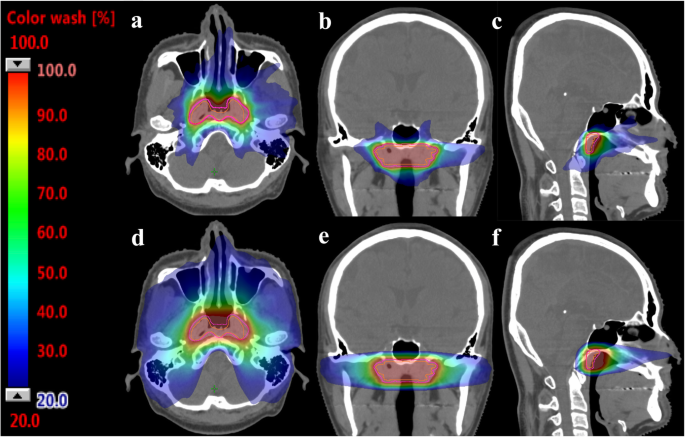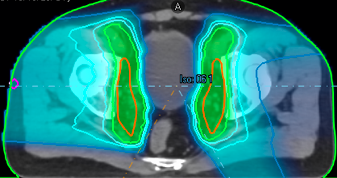Breast Cancer

Breast radiotherapy is a common and safe procedure.
Radiotherapy plays a crucial role in the treatment of breast cancer by using high-dose radiation to target and destroy cancer cells.
Find out more about radiotherapy after neoadjuvant chemotherapy.
Find out more about radiotherapy to the regional lymph nodes.
Find out more about when proton beam therapy maybe useful in breast cancers.
Head and neck Cancer

In head and neck cancer, radiotherapy is a key treatment modality used to target and destroy cancer cells. It can be applied as a primary treatment or in combination with surgery and/or chemotherapy.
Find out more about radiotherapy techniques in nasopharyngeal cancers.
Find out about options for locally recurrent nasopharyngeal carcinoma.
Find out more about Human Papilloma Virus related oral cancers.
Lung cancer

In lung cancer, radiotherapy can be given as ablative steoreotactic body radiotherapy for small tumours, or as external beam radiotherapy ( IMRT. VMAT or proton beam) for unresectable cancers.
Find out more about ablative radiotherapy (SBRT) for lung cancers.
Find out more about concurrent chemoradiotherapy for advanced lung cancers.

Sarcoma
Sarcomas are cancers that originate from cells that are responsible for forming soft tissue. These cancers are diverse and range from muscles, to bones, to vessels.
Childhood cancers

In pediatric cancer treatment, radiotherapy is often employed as part of a multimodal approach. However, its use in pediatrics requires careful consideration due to potential long-term side effects on developing tissues. Proton therapy is useful to minimize side effects in developing tissues.
Find out about proton radiotherapy and why childhood cancers benefit.
Endometrial cancers

Radiotherapy plays a role in the treatment of endometrial cancer by targeting and eliminating cancer cells in the uterus. It is typically used after surgery (such as hysterectomy) to reduce the risk of cancer recurrence, particularly in cases with adverse pathological features. External beam radiotherapy or brachytherapy (internal radiation) may be employed based on the extent and characteristics of the disease. Chemotherapy is added in node positive or high risk patients for systemic control. Radiotherapy is valuable in providing local control.

Esophageal Cancer
Esophageal cancers can be either squamous cell or adenocarcinoma. The latter tends to arise from the lower esophagus and requires multimodality treatment. For squamous cell carcinoma, cure with chemoradiotherapy is possible.

Rectal Cancer
Radiotherapy is a vital component in the management of locally advanced rectal cancer, often used before surgery (neoadjuvant) to shrink tumors, making them more surgically removable. This approach aims to reduce the risk of recurrence. Additionally, radiotherapy may be employed as the primary treatment for inoperable cases.

Urological Cancers
Radiotherapy can be curative for several urological cancers including prostate cancer and bladder cancer. New evidence suggests that it can even be used for kidney cancer. Radiotherapy can be delivered using volumetric modulated arc therapy (VMAT), intensity modulated radiotherapy (IMRT), Stereotactic body radiotherapy (SBRT) or intensity modulated proton therapy (IMPT). Click on the following to read more about:
Prostate Cancer
Bladder Cancer
Kidney Cancer

Pancreatic Cancer
The treatment of pancreatic cancer typically involves a multidisciplinary approach, including surgery, chemotherapy, and radiotherapy. Surgery, such as a Whipple procedure, is the primary option for localized tumors that can be resected. Chemotherapy, often with drugs like gemcitabine or FOLFIRINOX, is used to shrink tumors, control metastatic disease, and enhance surgical outcomes. Radiotherapy, including external beam and palliative radiotherapy, is used to manage localized disease, reduce tumor size, and alleviate symptoms
Recommendations for RT for patients with pancreatic cancer are typically made based on a few clinical scenarios:
Borderline resectable > to sterilise surgical margins
Unresectable > ablative radiotherapy for longer term control
Palliative > coeliac plexus SBRT for pain relief, or local RT for symptoms

Cervical cancer
The treatment of cervical cancer typically depends on the stage of the cancer. Non-invasive cancer can be managed with conization where only a part of the cervix is removed. Early-stage cervical cancer may be treated with surgery, such as a hysterectomy, where the uterus and possibly surrounding tissues are removed. Additionally, procedures like trachelectomy may be options for preserving fertility in younger patients. Radiation therapy, often in combination with chemotherapy, is often used for more advanced stages of cervical cancer. Radiotherapy is administered in the form of external beam and internal treatment ( brachytherapy). Immunotherapy and targeted therapy are emerging as potential treatments, particularly for advanced or recurrent cervical cancer.

Common skin cancers
Basal Cell Carcinoma (BCC):
- BCC is the most common type of skin cancer globally. It often appears in sun-exposed areas, especially the face, neck, and scalp.
Squamous Cell Carcinoma (SCC):
- SCC is the second most common skin cancer and is also associated with sun exposure. It is more aggressive than BCC and can spread to lymph nodes or other organs
Melanoma:
- Melanoma is less common but more dangerous than BCC and SCC. It can quickly spread to other parts of the body if not caught early. In asia, the subtype that occurs in the palms and soles are more common.
Cutaneous Angiosarcoma
Extra-mammary paget’s disease
Merkel Cell Carcinoma:
- MCC is rare but highly aggressive. It is linked to sun exposure and a weakened immune system.
Advantages of Radiotherapy for Skin Cancers
- Non-invasive: Ideal for patients who are not surgical candidates.
- Preservation of function and appearance: Useful in areas like the face, where surgery could lead to significant cosmetic or functional impairment.
- Adjunct to surgery: Radiotherapy can help ensure complete tumor eradication, especially for high-risk or recurrent cases.

Liver Cancer
Due to the liver’s sensitivity to radiation, highly precise technologies like stereotactic body radiotherapy and proton beam therapy should be used. Stereotactic body radiotherapy is more commonly used in the treatment of liver metastases from other cancers. In inoperable hepatocellular carcinoma (HCC), the use of proton radiotherapy is often determined on a case-by-case basis, considering factors such as tumor size, location, and the patient’s overall health. Many centers have reported high control rates for inoperable HCCs with proton therapy.

Brain Tumours
Radiotherapy is a crucial component in the treatment of brain cancer, aiming to target and destroy cancer cells within the brain. It can be used as a primary treatment for certain brain tumors or in combination with surgery and chemotherapy. Additionally, radiotherapy can be used palliatively to alleviate symptoms and improve the quality of life for patients with advanced or inoperable brain cancer.
For metastases from other sites, stereotactic radiosurgery can safely eradicate small tumours.
To find out more about the different types of gliomas, click here.
Palliative radiotherapy

Palliative radiotherapy is a type of radiation therapy that is primarily aimed at relieving symptoms and improving the quality of life for patients with advanced or metastatic cancer. Unlike curative or definitive radiotherapy, which is administered with the intent to eliminate or control the cancer, palliative radiotherapy is used to alleviate symptoms and manage complications associated with the disease.
Key aspects of palliative radiotherapy include:
Symptom Relief:
- Palliative radiotherapy is often employed to alleviate symptoms such as pain, bleeding, obstruction, or pressure caused by the tumor. It is particularly useful in cases where the cancer has spread to other parts of the body.
Localized Treatment:
- The radiation is typically focused on specific areas of the body where the tumor is causing symptoms. By targeting these localized areas, palliative radiotherapy can provide relief without treating the entire body.
Improving Quality of Life:
- Palliative radiotherapy aims to enhance the patient’s quality of life by reducing pain, improving function, and alleviating other distressing symptoms associated with advanced cancer.
Short Treatment Courses:
- Palliative radiotherapy often involves shorter treatment courses than curative radiotherapy. The goal is to provide relief quickly and with minimal disruption to the patient’s daily life.
Common types of palliative radiotherapy
Whole-brain radiotherapy
- hippocampal-sparing (memory preservation)
- memantine prophylaxis (to protect cognition)
Radiotherapy for bleeding
- stomach cancer
- bladder cancer
- rectal cancer
Pain
- bone metastases
- skin cancer deposits
Bulky tumours
- large breast tumours
- unresectable head and neck mass
Care and Support Services
Cancer care is multidisciplinary

Nutrition Guidance
Get tailored nutrition plans to boost health and wellness during treatment. 365 Cancer Prevention Society (365CPS) was founded in 2003 by Billy Wang who was then the DJ of FM97.2. The society is an Institution of Public Character (IPC) and registered with Singapore’s National Council of Social Service (NCSS). Read 365 CPS guide to nutrition to assist cancer patients.

Support groups
Discover how our specialized support services elevate patients' quality of life.

Exercise and rehab
Join our community support groups to share experiences and connect with others.
